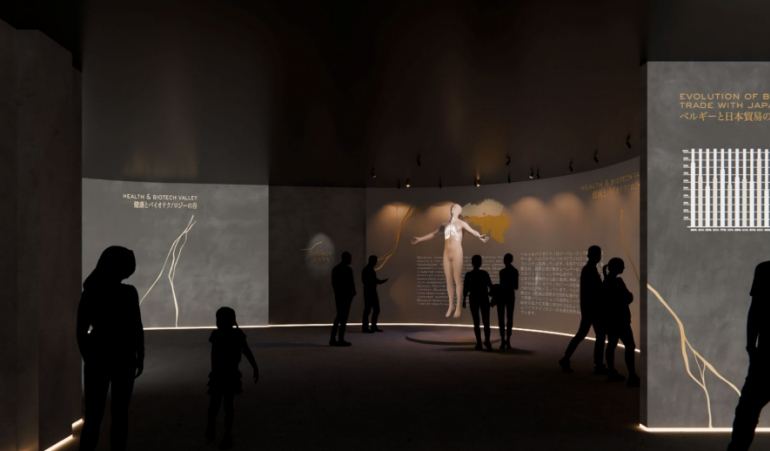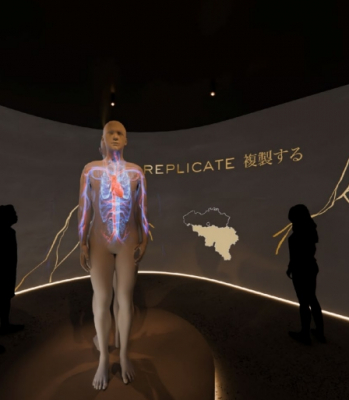
We already knew the name of the architect for the Belgian pavilion at the Osaka World Expo 2025: Cyril Rousseaux, from Carré 7 in La Louvière. This time, it's other Carolinians who have won the public contract to design our pavilion in Japan. The Dirty Monitor studio, specialized in video mapping, has teamed up with Barco, Profirst, Tempora and Show Tex Asia to offer visitors a unique immersive experience on the theme of health. Wallonia will be showcasing its know-how in the field of AI and, more specifically, digital twins.
“Saving lives

World Expo 2025, whose theme is “Designing the society of the future, imagining our life of tomorrow”, is being held in a particular economic, health and social context for Japan, which is facing challenges requiring innovative technologies and healthcare to improve the quality of life of its population. This is an opportunity to be seized by the Belgian pavilion, whose scenography will revolve around the sub-theme “Saving Lives”, highlighting the excellence of Belgian companies in healthcare research and development.
“Human Regeneration”

“Human Regeneration
The Consortium chosen to create the scenography for the Belgian pavilion decided to structure the visitor journey around the strong, unifying idea of human regeneration. This term evokes the improvement, transformation and renewal of a system (in this case, man as a living organism), as well as the ability to reconstitute an organ or tissue.Symbolically, it also evokes the regaining of strength and life in the face of adversity, a notion that echoes the field of healthcare and will be broken down into three axes in the Belgian pavilion:
REACT (preventing illness)
The pavilion will highlight Belgium's ability to develop and implement technologies to prevent disease and promote health on a global scale, including innovations in vaccination and disease surveillance.
REPAIR (to heal)
This curative vocation is expressed through healing mechanisms (drugs, prostheses, etc.) and the development of new tools for researchers and medicine.Artificial intelligence is playing an increasingly central role in research processes, as demonstrated by the theme chosen by Bruxelles-Capitale and Wallonia.In particular, our region will be focusing on digital twin technology.
This is a major advance in personalized medicine, as it enables treatments to be tailored to the unique genetics and physiology of each individual.
REGENERATE (pushing back the limits of human life)
This challenge, which will be developed by Flanders in its exhibition space, concerns all phases of life, from the fight against infertility, to the development of regenerative gene therapies (speech, memory, etc.), or ways of enabling ageing populations to live better and longer.
A graphic principle: Kintsugi

Anchored in the concept of Human Regeneration, the creative expression of the Belgian pavilion will be based on the graphic and aesthetic principle of Kintsugi.
This ancient Japanese technique for repairing broken ceramics highlights cracks rather than masking them. The method uses a special lacquer mixed with gold, silver or platinum powder to glue together the fragments of a broken object. The result is a piece embellished by shimmering veins in the broken areas, giving the object new life and a unique beauty.
Kintsugi embodies a philosophy that accepts imperfections and values objects despite - or because of - their flaws. In terms of health, it offers a powerful metaphor for the healing process, emphasizing not only resilience, but also the beauty and value that can emerge from repair after illness or injury.
An internationally recognized Belgian consortium
The winning consortium is made up of several strong, well-known players in the world of space and experience design.
The companies are Belgian with an international touch, given that their activities are global.
- Dirty Monitor is an artists' collective founded in Charleroi in 2004. Pioneers in digital art and video mapping, their notable collaborations with leading Belgian art directors such as Luc Petit and Franco Dragone have enabled them to spread their know-how around the world.
- Profirst is a Belgian events and communications agency. Combining artistic direction, strategy and high-end production, each event is conceived as an effective communication lever to reinforce the brand's image. Specializing in luxury, fashion and beauty, Profirst enjoys a worldwide reputation thanks to its many international clients.
- Tempora is a Belgian agency specializing in the design, production, promotion and management of exhibitions and cultural facilities. Based in Brussels, it develops major projects both in Belgium and abroad.Every year, the company welcomes more than 800,000 visitors to all the sites and exhibitions it operates.
- ShowTex Asia is active in the entertainment and events industry, and is a world leader in the invention, manufacture, sale and installation of innovative fireproof curtains.Its sewing workshops enable the rapid production of top-of-the-range, made-to-measure scenic elements. Also a supplier of technical elements and stage lighting, ShowTex is an excellent example of Belgian know-how, in constant search of innovation.
- Barco, based in Kortrijk, began by assembling radios from parts imported from the USA, hence the name “Barco” (Belgium American Radio Corporation).Today, this Belgian company specializing in digital projection and imaging technology focuses on entertainment, business and healthcare.
